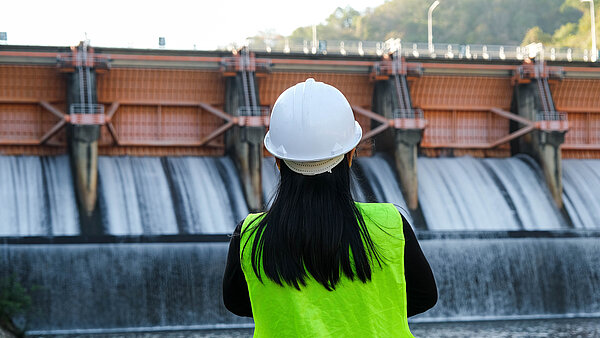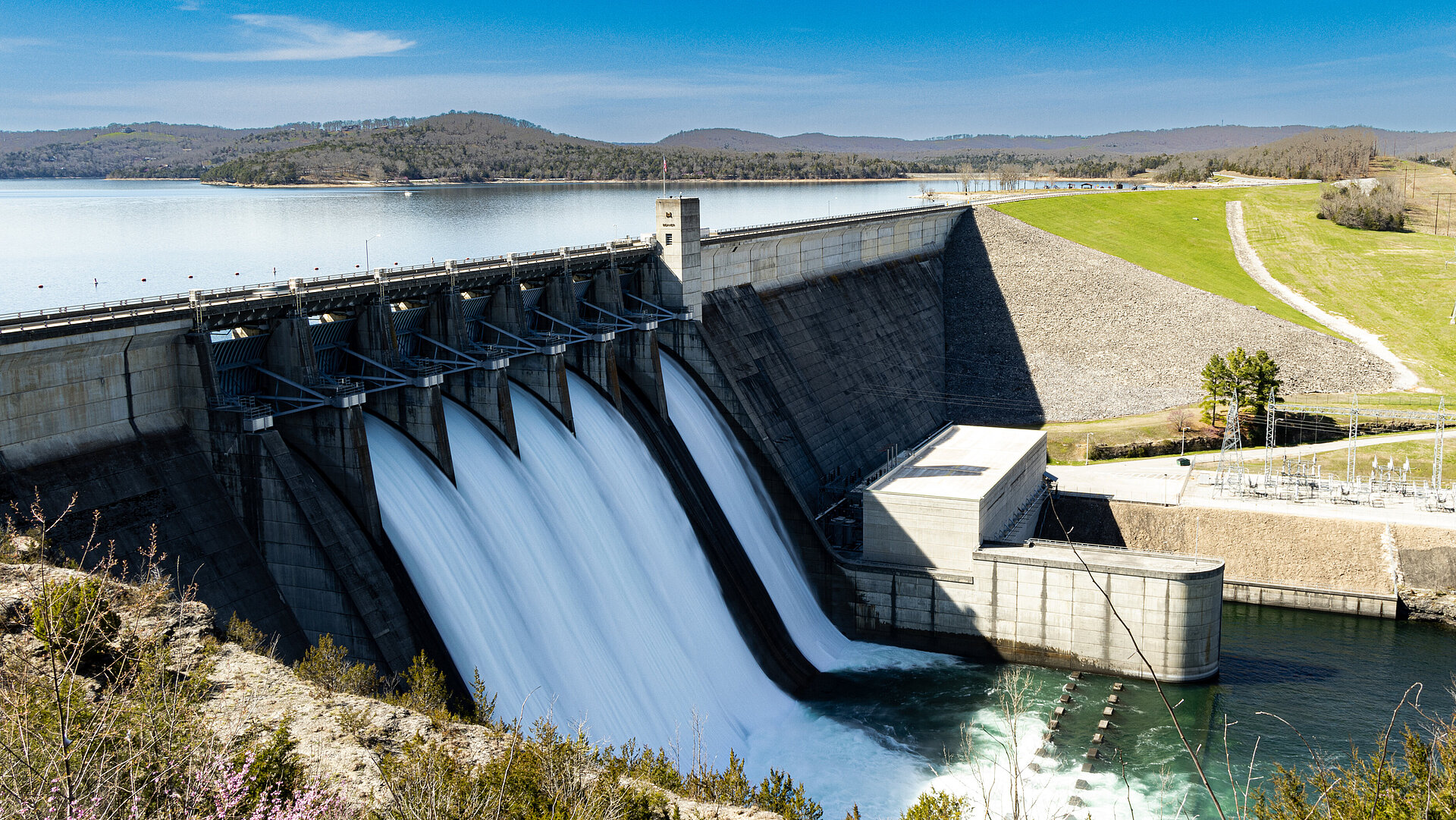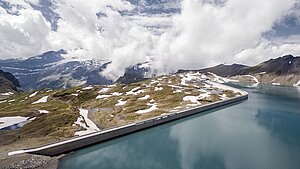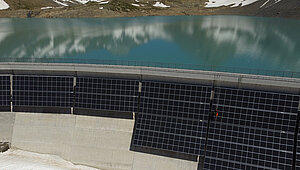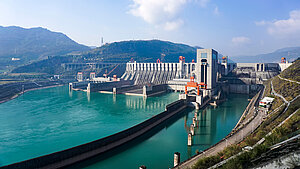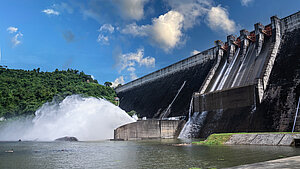This applies not only to reservoirs and hydro-electric plants per se, but also to the legally prescribed fish passes or ladders, which require maintenance. This is the only way for fish migratory routes, despite dam walls, to be kept clear of floating timber or similar at all times. In terms of legally conforming and safe operation of a hydro-electric plant, fall protection systems are an absolute must. And for several reasons. Not just the height of the dam walls, but also in the inside spaces of hydro-electric plants, a number of risks lurk which are further increased by the permanent moisture.
On top of this comes the proximity to running water which often has a very powerful flow. Under these circumstances a fall generally has severe consequences. A professional, certified fall protection system must therefore be optimally adaptable to the external circumstances. In addition, compliance with the corresponding safety protocols and concepts is of decisive importance.
The major danger areas from practice at a glance
In and on hydro-electric plants there is a multiplicity of danger situations which can be neutralised only by a fall protection system. A look at practice shows that above all in these 4 cases there is increased fall risk inside a hydro-electric plant for service and maintenance personnel, and appropriate protection must be provided:
Danger area 1: Fall risk at machinery and turbines
Here the danger arises above all from rotating parts. They must be built in such a way that under no circumstances can employees come in contact with them. For larger machinery, fall protection systems are sometimes required.
Danger area 2: Restricted views and lack of space, and also pits and shafts
This applies to all narrow opening flaps and all maintenance routes, such as descents, ascents, or ascent ladders which must be traversed by the personnel. These sometimes also lead into pits and shafts – there is naturally always acute fall risk here. A professional fall protection system, including appropriate personal protective equipment (PPE), is a must.
Danger area 3: Working close to water
The risk of stumbling or slipping also exists indoors, because people often move on wet surfaces. Furthermore, water is ubiquitous, even indoors. The danger of drowning after stumbling or slipping into flowing water therefore also exists here.
Danger area 4: Water flows and levels
Here, the greatest danger arises principally from changing water levels and from the flow. It must therefore be possible to perform all tasks in such a way that the service and maintenance workers are not carried away by the water under any circumstances. Only a fall protection system can provide the necessary safeguard here.
Danger area 5: Narrow maintenance routes and fish ladders
Both indoors and outdoors, the maintenance routes of hydro-electric plants are narrow and wet – and therefore slippery. Floating timber can also be a danger here. In addition, fish ladders continuously require cleaning, so that the fish can always pass through. Our Vandans reference project demonstrates what this can look like in practice.
Danger area 6: Roofs and canopies
Roofs represent a fall risk at all times, but in hydro-electric plants, because of their structures and permanent wetness on surfaces, this risk is very much greater. Here, a guardrail, rail or lifeline system creates a remedy to eliminate the danger.
Furthermore, tasks on and in hydro-electric plants become a challenge in terms of worker safety because of the following factors:
- Height in general
- Falling objects
- High water events
- Ice formation
It is essential that these danger areas are identified, prevented, and managed appropriately when it comes to assuring as far as possible the safety of employees in hydro-electric plants and reservoirs. This requires training courses, appropriate equipment, modern and certified safety solutions, and regular inspections, in order to minimise risks and prevent accidents.
Accident prevention – what really matters
Prevention is better than cure. And this applies quite particularly to hydro-electric plants, because falls generally have severe consequences for the injured workers themselves. But it can also become unpleasant for the plant operators, especially when too little has been done in advance for the safety of all servicing and maintenance workers. In that case, consequences under criminal law cannot be excluded.
Against this background, in addition to a well-founded safety concept, professional, certified fall protection systems including all required elements and components, plus personal protective equipment against falls from a height (anti-fall PPE), also play an important role. They contribute to preventing accidents and injuries, and thus minimise the risk for all operating personnel and also potential legal liability risks for the employer.
However, a well-founded safety concept must also include the care and protection of the safety equipment. It may be necessary to replace elements when they no longer meet the required safety standards, or are damaged. However, doing this can also significantly reduce downtimes and repair costs.
In the worst case ...
However, despite all precautionary measures and safety precautions, accidents can never be prevented entirely in hydro-electric plants. This is why rescue and recovery of employees involved in an accident are essential components of a well-founded safety concept. This also implies that the operators of the plants ensure that the necessary means and equipment are in place to ensure professional initial care of the accident victims as quickly as possible.
Regardless whether indoors or outdoors, for a hydro-electric plant the rescue or recovery of casualties is always also associated with major risks. For this too, professional safety solutions and personal protective equipment against falls from a height must be made available.
But ongoing training and sensitisation of the affected workers are also essential, in order to increase the consciousness of the dangers in these exposed workplaces. But the best safety concept combined with the most up-to-date equipment is of no effect if the service employees and cleaning and maintenance workers in the respective danger zones are not themselves conscious of their portion of responsibility.
They must also use all installed and prescribed fall protection systems, including anti-fall PPE and helmets, as well as possibly life jackets in the case of hydro-electric plants.
Potential safety solutions in and on hydro-electric plants
But there is good news too! All the danger areas described above can be secured professionally. Firstly, this helps to provide 100% safety for all service and maintenance workers, and secondly it ensures that all legal safety regulations are in fact complied with in full. Here, we have assembled an extract of potential fall protection systems for hydro-electric plants:
AIO lifeline system
The lifeline system is a proven safety solution and is characterised by its simple installation. Our Vandans reference project is an example of the use of a lifeline system where a fish ladder had to be protected against falls. Specifically, the AIO passable-overhead lifeline system was deployed as the safety solution. Find out the challenges which this project had to overcome in the blog post Success Story Fall Protection Hydro-electric Plant illwerke Vandans.
TAURUS rail system
The rail system is an optimum fall protection system for indoors and outdoors. It enables completely flexible protection of vertical ascents and descents. In the case of a hydro-electric plant, these can occur on ladders or steep, narrow steps.
But rail protection can also protect the dam wall itself against falls. Our reference example Hydropower plant with a PV installation, the pioneering project AlpinSolar at a glance demonstrates how such a solution can work in practice. TAURUS is a winner primarily because of its great adaptability to the respective structures and characteristics. The TAURUS ALLROUND system variant provides ideal protection for service and maintenance technicians on sloping accesses, and also on transitions, and horizontal and vertical planes.
Single anchor points - EAPs
Single anchor points (EAPs) like the EAP-TEL-10 (telescopic rods) from INNOTECH, in combination with the EAP-TEL-20-VZ mount, are an individual protection solution, and are optimally suited for shaft entries, such as those often found in hydro-electric plants. In addition, the EAP-TEL-10 is mobile and can conveniently be carried in a rucksack to the next danger areas. Furthermore, this solution can be attached without any tool whatsoever.
The TAURUS-SCE-10 also reliably protects the entry and exit to/from shafts. However, this is a push-on support which can be used only with the TAURUS rail system. The TAURUS-SCE-10 is also removable, and is attached to the ladder located at the shaft entry. Here a rail system (TAURUS-VERTIKAL) as well as the TAURUS-SCE-50-A4 shaft bracket must already have been installed.
Attention: EAPs must always be used in combination with anti-fall PPE.
BARRIER guardrail system:
The guardrail system is available in different variants. In hydro-electric plants, BARRIER is used mainly out of doors or on platforms, in order to protect fall edges professionally. But BARRIER is also suitable as a safety solution for ascents and ascent ladders. For this, the system is attached at left and right of the upper end of the ascent, and also along the fall edge, in order to protect the service and maintenance workers from falls.
The legal provisions
Hydro-electric plant operators are responsible for the safety of their employees, and must therefore install the optimally suited safety solution on and in their plant. In many countries there are strict regulations and laws about industrial safety, and these prescribe the presence of fall protection systems in industrial plants such as hydro-electric plants.
In this regard, the concrete provisions are specified:
- for Germany, in the Arbeitsschutzgesetz [industrial protection law (ArbSchG)]
- for Austria, in the ArbeitnehmerInnenschutzgesetz [Workers Protection Act (ASchG)]
- for Switzerland, in the Verordnung über die Verhütung von Unfällen und Berufskrankheiten (VUV) [regulation relating to accident prevention and occupational illnesses]
Compliance with these regulations is necessary to avoid fines and legal consequences. In Austria, Switzerland, and Germany the legal minimum standards are controlled by the respective accident insurance organisations. The responsible accident insurance organisations in Austria, Switzerland, and Germany:
- Österreichische Unfallversicherung (AUVA)
- Schweizerische Unfallversicherungsanstalt (Suva)
- Deutschen Gesetzliche Unfallversicherung (DGUV)
The blog post Safety on a hydro-electric plant - what does that have to do with fall protection? contains detailed information about this.
Example of fall protection on a dam wall equipped with PV panels
The AlpinSolar pilot project demonstrates how hydro-electric plants can also be used optimally for generating solar power. For this, the approximately 1,000 metre long and more than 30 metre high dam wall of the hydro-electric plant on the Muttsee reservoir in the midst of the Glarus area of the Swiss Alps was equipped with PV panels, and thus became both the largest and highest solar power plant in Switzerland. At over 2,500 metres above sea level, AlpinSolar now feeds around 2.2 Megawatts of power into the network and generates about 3.3 million kilowatt hours of environmentally friendly power.
From the very start, the project managers included the safety of all service and maintenance workers in their focus. For this reason, the total of 5,000 PV modules were also equipped with a professional and reliable safety solution – for the protection of the personnel, but also to consistently maintain the performance of the solar power plant at the best level.
When looking for a user-friendly and easy-to-install fall protection system which also optimally withstands the extreme alpine weather conditions, the operators of the Muttsee hydro-electric plant decided in favour of the TAURUS rail system from INNOTECH. This solution is characterised by its robustness and its great adaptability to very varied structures. The PV installers can therefore attach every single panel to the dam wall with pinpoint precision, and the panels can later by maintained and cleaned.
Further success stories summarised short and sweet
The Limmern pumped storage plant
Back in 2009 a pumped storage plant was connected to the Muttsee hydro-electric plant, in order to convert or save excess power created during off-peak periods into valuable peak-load energy. The output of this “battery” is approximately 1000 MW. For this project too, the operators of the hydro-electric plant took the subject of safety very seriously, because the tasks inside the dam wall at angles up to 52 degrees represented a high level of slipping and sliding risk for the fitters. But in addition a roughly 20 metre long set of steps with a small platform to the next level had also to be professionally protected.
The challenges
- Securing the sloping accesses of up to 52 degrees inside the dam wall with only a partial handrail on one side
- Securing the set of steps having a length of 20 metres before the next step platform starts. A fall without appropriate fall protection could not be survived.
- The danger of falling into the flowing water via an adjacent canal had to be completely neutralised.
- The location of the reservoir in the high Alps made delivery of the required materials more difficult.
The safety solution:TAURUS ALLROUND rail system
The right fall protection system for the Vandans hydro-electric plant
In Vandans a fish ladder required appropriate professional protection, in order that it could be maintained, cleaned, and inspected regularly. In the end, what matters is that the passage is free at all times and the fish can migrate through it unimpeded.
To ensure this, an optimally matching fall protection system was necessary, including associated safety equipment such as anti-fall PPE, helmets, life jackets, and non-slip shoes. In this case, the INNOTECH experts recommended the AIO lifeline system, because no static structures were available in Vandans for the installation of a fall protection system. First of all, therefore, a steel structure had to be developed, to which the AIO LIFELINE SYSTEM PASSABLE-OVERHEAD could be attached. After this, all maintenance and service employees were trained appropriately, so that they could independently install the fall protection also at other locations operated by the illwerke company.
The challenges
- No static structure available for installing the fall protection system
- Development of a special solution using a gallows design and overhead cable system
- For tasks adjacent to flowing water, safety had to be ensured, and will have to be ensured in future
The safety solution:AIO PASSABLE OVERHEAD LIFELINE SYSTEM
If you need more information about professional, certified fall protection systems for hydro-electric plants, then the best thing you can do is to download our “Tip Sheet” about this subject!








